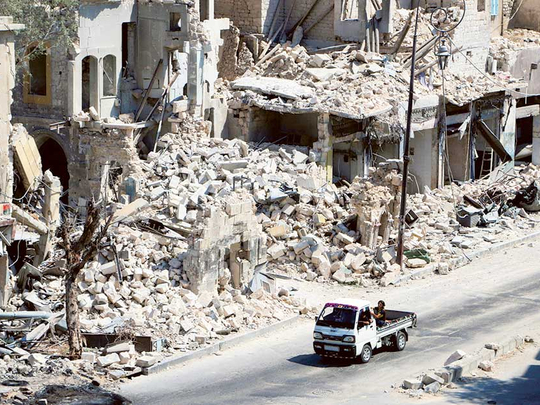
Beirut: Residents of the northeastern Syrian city of Hassakeh took advantage on Friday of a lull in the fighting between Kurdish forces and Syrian government troops to flee to safer areas nearby, after fighting intensified the previous day with government warplanes bombing Kurdish-controlled positions in the city for the first time, activists and others said.
Shortly afterward, clashes broke out anew, a Kurdish official said.
The fighting between the Kurdish troops and government forces could add a new dimension to the country’s deadly war, now in its sixth year, by potentially opening a new front in Syria.
The area around Hassakeh had witnessed battles between the two sides in the past but this week’s violence has been among the worst since Kurdish fighters took control of wide, predominantly Kurdish areas in northern Syria in 2012.
The main Kurdish force in Syria, known as the People’s Protection Units, or YPG, has been the most effective force in fighting Daesh. Last week, the Syria Democratic Forces, a coalition led by the YPG, captured the former Daesh stronghold of Manbij in northern Syria under the cover of air strikes by the US-led coalition.
Earlier in the month, Iran’s Foreign Minister, Mohammad Javad Zarif, travelled to Turkey for talks with that country’s officials. Turkish Foreign Minister Mevlut Cavusoglu visited Tehran on Thursday. Both countries pledged greater cooperation on resolving the Syria crisis, despite the fact they support opposing sides in the war — Iran is a staunch Al Assad ally while Ankara backs Syria’s rebels and Al Assad’s rivals.
However, Turkey and Iran have large Kurdish communities and both appear to be concerned about Syria’s Kurds gaining more areas under their control on the border with Turkey. Ankara also considers the YPG a terrorist organisation because of its links to Turkey’s outlawed Kurdistan Workers’ Party, or PKK.
The Britain-based Syrian Observatory for Human Rights, an activist group that tracks the conflict, said the fighting first began on Wednesday. So far, 16 people, including six women and children, have been killed on the Kurdish side. Five pro-government gunmen of the National Defense Force were killed as well, the Observatory said.
Later on Friday, SDF official Nasser Haj Mansour said that fighting erupted again and was under way in several neighbourhoods of the city. The YPG fighters captured several areas, including the wheat silos and the economics college, he said, adding that the Kurdish troops were advancing in the central neighbourhoods of Ghweiran and Nashwa.
“We are fighting mercenaries,” Haj Mansour said, in reference to pro-government gunmen fighting on the side of President Bashar Al Assad’s forces.
Jwan Mohammad, a former Kurdish official, said there was intense fighting overnight. A relative calm on Friday morning prompted scores to flee, mostly to nearby towns of Qamishli and Amouda. Speaking from Qamishli, he said that there were calls through mosques’ loudspeakers for the evacuation of civilians stuck in the areas of fighting.
The Observatory also reported residents were fleeing the city and that clashes picked up in the afternoon again. The Beirut-based pan-Arab Al Mayadeen TV quoted an unnamed Syrian military official as saying that the clashes broke out anew after YPG fighters attacked military positions in the city on Friday.
YPG spokesman Redur Khalil denounced Thursday’s government air raids on Hassakeh as an act of “suicide”, adding that Al Assad’s forces would be held accountable for these “brutal, blatant attacks against our people.”












